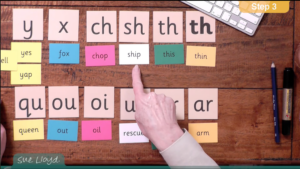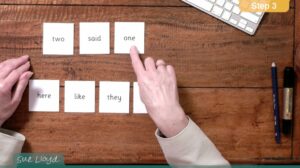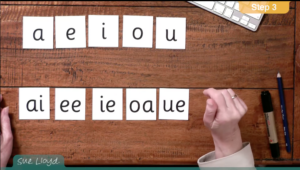Part 3 – Capital letters and decodable readers
Part 3 – Capital letters and decodable readers
Capital letters are introduced, which includes teaching their sounds and how to form them correctly. This prepares the children for reading and writing sentences, as well as for reading decodable books.
Transcript
Print TranscriptPart 3: Capital letters and decodable readers
There are 20 tricky words in Step 3. Not only should the children be able to read them, they should also learn how to write and spell them correctly. A good way to do this is to look carefully at one word at a time, identify the awkward bit, cover it up and write it; then check the spelling, hide it and write it again [demonstration]. The tricky word spelling sheets can be downloaded in the usual way, by scrolling down to the bottom of the page in Step 3 or by going to the Resources section on the home page.
Before the children are ready to start reading sentences, they need to learn about capital letters. Some capitals are a similar shape to their lower-case letters, and are just larger: C O P S U V X W Z. These are easy for the children to recognise. The others have different shapes and the sounds for them should be taught. The children need to understand that each capital has the same sound as its lower-case letter, even though they may look different [demonstration].
Now, with knowledge of 20 tricky words and the sounds linked to the capital letters, the children are ready to read sentences. These sentences use only letter sounds and tricky words that have been taught [demonstration]. Some of these sentences are questions, which encourages a response from the children and are frequently humorous; the others are ordinary sentences which provide more practice, which is always necessary in teaching [demonstration]. These sentences can be put on a table and read by the children individually, or the children can read them to each other in pairs, or they can be written on the board in the classroom for all the children to try and read [demonstration]. There are many ways of presenting the same thing, which brings variety and interest to the teaching.
We know the sounds of the capital letters need to be known for reading sentences, but that also applies to writing sentences. The children have to learn how to form the capital letters correctly, as well as write them neatly, and the capital letter formation sheets provide the necessary practice. Once these are known, sentences can be dictated for the children to write. The teacher might, for example, dictate He slept in a tent for the children to write down: they would need to think about how to write the tricky word he, remembering to start with a capital H, then listen for the sounds in the other words before writing them down, leaving a space between each word, and ending with a full stop [demonstration]. Dictating sentences like this develops the skill of writing, as well as giving the children an understanding of what a sentence is: a group of words that has a capital letter at the beginning, a full stop at the end and that makes sense. Suitable sentences for dictation, as well as the capital letter formation sheets, can be downloaded in the usual way, by either scrolling down to the bottom of the screen in Step 3, or by going to the Resources section on the home page.
At this stage, the children who are confident in working out words and reading sentences are now ready to be given the first level of reading books to take home and read to their parents or guardians. It is important that these books are decodable, which means that they only have words that use the letter sounds taught so far, along with a few of the tricky words that the children know. You can see the foundation skills that are needed in the first level of the Jolly Phonics Readers. The first page shows the letter sounds that the children need to know and blend, as well as the tricky words used, and there are also some comprehension questions at the back [demonstration]. When the children have these skills, and can read the names of the main characters, Inky, Snake and Bee, they are able to read the books with confidence and enjoyment. Other decodable readers are also available, and there is more information about them on the home page, in the section Phonic knowledge, under the heading Decodable readers.
It is recommended that decodable readers are used until a child knows the letter sounds taught in Steps 1 to 5, is fluent and confident at reading, and automatically uses blending to work out any unknown words. By this time, the children have the ability to read any books which are suitable for their age and that are within their understanding. They have cracked the code and are now free readers. After that, it is a matter of encouraging the children to read as much as possible by joining libraries and book clubs, swapping books, talking about their favourites, and so on.
Tricky Words are frequently used words that either use alternative spellings that have not been taught yet or they are irregular. The children have to learn the awkward part for spelling. These sheets allow the children to practise writing the tricky words, using the Look, Cover, Write & Check method.
Tricky Words are frequently used words that either use alternative spellings that have not been taught yet or they are irregular. The children have to learn the awkward part for spelling. These sheets allow the children to practise writing the tricky words, using the Look, Cover, Write & Check method.
Tricky Words are frequently used words that either use alternative spellings that have not been taught yet or they are irregular. The children have to learn the awkward part for spelling. These sheets allow the children to practise writing the tricky words, using the Look, Cover, Write & Check method.
Tricky Words are frequently used words that either use alternative spellings that have not been taught yet or they are irregular. The children have to learn the awkward part for spelling. These sheets allow the children to practise writing the tricky words, using the Look, Cover, Write & Check method.
It is important to give children reading material that they can decode for themselves. Often they feel that books are too hard for them. These Question Sentences can help to fill the gap. They are sometimes amusing and provide another source of reading practice.
It is important to give children reading material that they can decode for themselves. Often they feel that books are too hard for them. These Question Sentences can help to fill the gap. They are sometimes amusing and provide another source of reading practice.
These sentences use the 42 letter sounds and tricky words 1-20. They provide more reading practice. Use in a similar way to the Question Sentences.
These sentences use the 42 letter sounds and tricky words 1-20. They provide more reading practice. Use in a similar way to the Question Sentences.
These words have been carefully selected. The children should be able to spell the dictated words correctly by listening for the sounds in the words and writing letters to represent the sounds. The words build up progressively until all 12 letter sounds are used.
These words have been carefully selected. The children should be able to spell the dictated words correctly by listening for the sounds in the words and writing letters to represent the sounds. The words build up progressively until all 12 letter sounds are used.
These words have been carefully selected. The children should be able to spell the dictated words correctly by listening for the sounds in the words and writing letters to represent the sounds. The words build up progressively until all 12 letter sounds are used.
These words have been carefully selected. The children should be able to spell the dictated words correctly by listening for the sounds in the words and writing letters to represent the sounds. The words build up progressively until all 12 letter sounds are used.
These sentences use the 42 letter sounds and tricky words 1 - 20. The children write the sentences from dictation either in the classroom or at home.
Guidance for forming the capital letters is shown by arrows and dots, which provides the children with the necessary practice and skills.
Guidance for forming the capital letters is shown by arrows and dots, which provides the children with the necessary practice and skills.
The next 12 letter sounds taught in Step 3 are provided. They can be used as flash cards to help the children remember the sounds linked to the letters or for word building.
The next 12 letter sounds taught in Step 3 are provided. They can be used as flash cards to help the children remember the sounds linked to the letters or for word building.
On these sheets the children are able to practise forming the next 12 letters correctly by following the dots.
On these sheets the children are able to practise forming the next 12 letters correctly by following the dots.
On these sheets the children are able to practice forming the next 12 letters correctly by following the dots.
On these sheets the children are able to practice forming the next 12 letters correctly by following the dots.
The words from the Word Bank can be printed on coloured card, cut up and used for blending practice. As each new letter sound is taught then more words become available for blending.
The words from the Word Bank can be printed on colored card, cut up and used for blending practice. As each new letter sound is taught then more words become available for blending.
The Step 3 phrases can be printed on card, cut up and used for reading practice. They are slightly more challenging than reading single words. It helps to prepare the children for reading sentences.
The Step 3 phrases can be printed on card, cut up and used for reading practice. They are slightly more challenging than reading single words. It helps to prepare the children for reading sentences.
The Step 3 phrases can be printed on card, cut up and used for reading practice. They are slightly more challenging than reading single words. It helps to prepare the children for reading sentences.
The Step 3 phrases can be printed on card, cut up and used for reading practice. They are slightly more challenging than reading single words. It helps to prepare the children for reading sentences.
Tricky Words are frequently used words that either use alternative spellings that have not been taught yet or they are irregular. They can be blended but give the wrong pronunciation. The children have to remember the correct pronunciation and learn the unusual letter-sound correspondences.
Tricky Words are frequently used words that either use alternative spellings that have not been taught yet or they are irregular. They can be blended but give the wrong pronunciation. The children have to remember the correct pronunciation and learn the unusual letter-sound correspondences.
Tricky Words are frequently used words that either use alternative spellings that have not been taught yet or they are irregular. They can be blended but give the wrong pronunciation. The children have to remember the correct pronunciation and learn the unusual letter-sound correspondences.
Tricky Words are frequently used words that either use alternative spellings that have not been taught yet or they are irregular. They can be blended but give the wrong pronunciation. The children have to remember the correct pronunciation and learn the unusual letter-sound correspondences.
Tricky Words are frequently used words that either use alternative spellings that have not been taught yet or they are irregular. The children have to learn the awkward part for spelling. These sheets allow the children to practise writing the tricky words, using the Look, Cover, Write & Check method.
Tricky Words are frequently used words that either use alternative spellings that have not been taught yet or they are irregular. The children have to learn the awkward part for spelling. These sheets allow the children to practise writing the tricky words, using the Look, Cover, Write & Check method.
Tricky Words are frequently used words that either use alternative spellings that have not been taught yet or they are irregular. The children have to learn the awkward part for spelling. These sheets allow the children to practise writing the tricky words, using the Look, Cover, Write & Check method.
Tricky Words are frequently used words that either use alternative spellings that have not been taught yet or they are irregular. The children have to learn the awkward part for spelling. These sheets allow the children to practise writing the tricky words, using the Look, Cover, Write & Check method.
It is important to give children reading material that they can decode for themselves. Often they feel that books are too hard for them. These Question Sentences can help to fill the gap. They are sometimes amusing and provide another source of reading practice.
It is important to give children reading material that they can decode for themselves. Often they feel that books are too hard for them. These Question Sentences can help to fill the gap. They are sometimes amusing and provide another source of reading practice.
These sentences use the 42 letter sounds and tricky words 1-20. They provide more reading practice. Use in a similar way to the Question Sentences.
These sentences use the 42 letter sounds and tricky words 1-20. They provide more reading practice. Use in a similar way to the Question Sentences.
These words have been carefully selected. The children should be able to spell the dictated words correctly by listening for the sounds in the words and writing letters to represent the sounds. The words build up progressively until all 12 letter sounds are used.
These words have been carefully selected. The children should be able to spell the dictated words correctly by listening for the sounds in the words and writing letters to represent the sounds. The words build up progressively until all 12 letter sounds are used.
These words have been carefully selected. The children should be able to spell the dictated words correctly by listening for the sounds in the words and writing letters to represent the sounds. The words build up progressively until all 12 letter sounds are used.
These words have been carefully selected. The children should be able to spell the dictated words correctly by listening for the sounds in the words and writing letters to represent the sounds. The words build up progressively until all 12 letter sounds are used.
These sentences use the 42 letter sounds and tricky words 1 - 20. The children write the sentences from dictation either in the classroom or at home.
Guidance for forming the capital letters is shown by arrows and dots, which provides the children with the necessary practice and skills.
Guidance for forming the capital letters is shown by arrows and dots, which provides the children with the necessary practice and skills.


